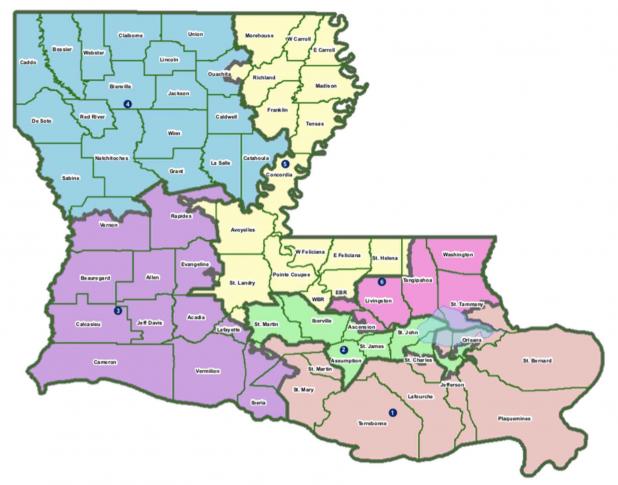
Courtesy of state Sen. Cleo Fields
This map shows one version of Democratic proposals to shrink the width of the 5th District in northeast Louisiana, now represented by Republican Rep. Julia Letlow, and extend it down to Baton Rouge to create what would likely be a second majority-minority district.
Battle lines are drawn for remapping session
BATON ROUGE–Battle lines were being drawn between Democrats and Republi-cans in the Louisiana Legislature Tuesday as the two sides proposed new congressional maps as a special redistricting session got underway.
Democrats are pushing for a second of the six congressional districts that would be likely to elect a Black representative.
Map proposals filed by State Sen. Cleo Fields, D-Baton Rouge, would redraw con-gressional District 5 to be majority black. The district is currently represented by Republican Rep. Julie Letlow.
The new district would run down from the northeast corner of the state, hugging the Mississippi border and going as far south as East Baton Rouge Parish.
On the other side of the trenches, Repub-licans are proposing to make minor changes to current congressional maps, preserving the current balance of power in in the congressional delegation.
A proposal filed by House Speaker Clay Schexnayder, R-Gonzales, would keep two likely Republican congressional districts based in north Louisiana, despite major population shifts from the north to the southeast part of the state.
Democratic legislators and civil-rights groups say that with Black residents making up a third of the state’s population, two of Louisiana’s six congressional districts should be majority Black.
The state currently has a single majority Black congressional district, District 2, which encompasses the black populations of Baton Rouge and New Orleans. It is represented by Rep. Troy Carter, a Democrat.
The push for two majority Black congressional districts has drawn intense outside interest. For months prior to the session, the Joint Governmental Affairs Committee traveled to different parts of the state to hear public comments.
At each of these roadshows, as many took to calling them, representatives from the NAACP and progressive groups like Louisiana Progress came to advocate for two majority-minority districts.
These groups proposed a plethora of maps for legislators to consider. The NAACP put forward seven maps, each showing a different way to add a second majority Black district.
Republicans have been relatively tight-lipped about their thoughts on the proposals.
Rep. Tanner Magee, R-Houma and the House Speaker Pro Tempore, would not en-tirely rule out the possibility of a second Black district. But he expressed skepticism that such a district would be possible due to the geographic spread of the state’s black population.
“The last time we tried to do that, we had what they call the Zorro District, which Z’d across the state,” Magee said. “And then that got ruled unconstitutional.”
Peter Robbins-Brown, the executive director of Louisiana Progress, disagreed with that assessment.
“It’s difficult when you have six of these across the size of Louisiana to draw a truly compact map,” Robbins-Brown said. “Which is why compactness should not be a priority.”
Robbins-Brown said Fields’ maps were reminiscent of those put forward by the NAACP Legal Defense Fund. He added that those maps were more compact by every measure of compactness than the current congressional map.
While Gov. John Bel Edwards, a rare Democratic governor in a red state, has not completely ruled out signing a map that does not have two black congressional dis-tricts, he has said that such maps would have “defects in terms of basic fairness.”
Last month, Edwards defined what he meant by fairness. “Fairness, if it can be done, would be to have two out of the six congressional districts be minority districts,” he said.
Still, Edwards said in January that he would consider signing a map that included just one Black district if it included an “influence district” where the Black popula-tion was large enough to influence the outcome of the election.
In Schexnayder’s proposal, excluding the single Black district, the Black population does not rise above 33.6% in any of the five remaining districts.
State Sen. Sharon Hewitt, R-Slidell and the chairwoman of the Senate Governmental Affairs Committee, proposed maps that were slightly different than Schexnayder’s but that also would likely keep two northern Louisiana congressional districts in Republican hands.
Hewitt’s committee and a similar committee in the House will consider the various proposals before they go to the House and Senate floors.
Legislators also are redrawing some of the 105 state House seats and 29 state Senate seats to reflect population changes recorded in the 2020 Census.
